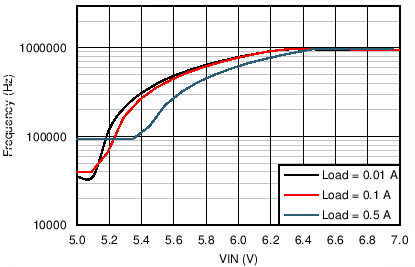ZHCSCW5B August 2014 – September 2017 LM43600
PRODUCTION DATA.
- 1 特性
- 2 应用
- 3 说明
- 4 简化电路原理图
- 5 修订历史记录
- 6 Pin Configuration and Functions
- 7 Specifications
-
8 Detailed Description
- 8.1 Overview
- 8.2 Functional Block Diagram
- 8.3
Feature Description
- 8.3.1 Fixed Frequency Peak Current Mode Controlled Step-Down Regulator
- 8.3.2 Light Load Operation
- 8.3.3 Adjustable Output Voltage
- 8.3.4 Enable (ENABLE)
- 8.3.5 VCC, UVLO and BIAS
- 8.3.6 Soft Start and Voltage Tracking (SS/TRK)
- 8.3.7 Switching Frequency (RT) and Synchronization (SYNC)
- 8.3.8 Minimum ON-Time, Minimum OFF-Time and Frequency Foldback at Dropout Conditions
- 8.3.9 Internal Compensation and CFF
- 8.3.10 Bootstrap Voltage (BOOT)
- 8.3.11 Power Good (PGOOD)
- 8.3.12 Overcurrent and Short-Circuit Protection
- 8.3.13 Thermal Shutdown
- 8.4 Device Functional Modes
-
9 Applications and Implementation
- 9.1 Application Information
- 9.2
Typical Applications
- 9.2.1 Design Requirements
- 9.2.2
Detailed Design Procedure
- 9.2.2.1 Custom Design With WEBENCH® Tools
- 9.2.2.2 Output Voltage Setpoint
- 9.2.2.3 Switching Frequency
- 9.2.2.4 Input Capacitors
- 9.2.2.5 Inductor Selection
- 9.2.2.6 Output Capacitor Selection
- 9.2.2.7 Feedforward Capacitor
- 9.2.2.8 Bootstrap Capacitors
- 9.2.2.9 VCC Capacitor
- 9.2.2.10 BIAS Capacitors
- 9.2.2.11 Soft-Start Capacitors
- 9.2.2.12 Undervoltage Lockout Setpoint
- 9.2.2.13 PGOOD
- 9.2.3 Application Performance Curves
- 10Power Supply Recommendations
- 11Layout
- 12器件和文档支持
- 13机械、封装和可订购信息
封装选项
请参考 PDF 数据表获取器件具体的封装图。
机械数据 (封装 | 引脚)
- PWP|16
散热焊盘机械数据 (封装 | 引脚)
- PWP|16
订购信息
8.3.8 Minimum ON-Time, Minimum OFF-Time and Frequency Foldback at Dropout Conditions
Minimum ON-time, TON-MIN, is the smallest duration of time that the HS switch can be on. TON-MIN is typically 125 ns in the LM43600. Minimum OFF-time, TOFF-MIN, is the smallest duration that the HS switch can be off. TOFF-MIN is typically 200 ns in the LM43600.
In CCM operation, TON-MIN and TOFF-MIN limits the voltage conversion range given a selected switching frequency. The minimum duty cycle allowed is
And the maximum duty cycle allowed is
Given fixed TON-MIN and TOFF-MIN, the higher the switching frequency the narrower the range of the allowed duty cycle. In the LM43600, frequency foldback scheme is employed to extend the maximum duty cycle when TOFF-MIN is reached. The switching frequency will decrease once longer duty cycle is needed under low VIN conditions. The switching frequency can be decreased to approximately 1/10 of the programmed frequency by RT or the synchronization clock. Such wide range of frequency foldback allows the LM43600 output voltage to stay in regulation with a much lower supply voltage VIN. This leads to a lower effective Dropout voltage. See Typical Characteristics for more details.
Given an output voltage, the choice of the switching frequency affects the allowed input voltage range, solution size and efficiency. The maximum operatable supply voltage can be found by
At lower supply voltage, the switching frequency will decrease once TOFF-MIN is tripped. The minimum VIN without frequency foldback can be approximated by
Taking considerations of power losses in the system with heavy load operation, VIN-MIN is higher than the result calculated in Equation 7 . With frequency foldback, VIN-MIN is lowered by decreased FS. Figure 42 gives an example of how FS decreases with decreasing supply voltage VIN at Dropout operation.
 Figure 42. Switching Frequency Decreases in Dropout Operation
Figure 42. Switching Frequency Decreases in Dropout Operation
VOUT = 5 V FS = 1 MHz